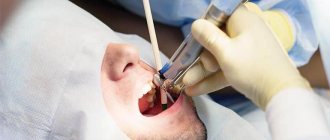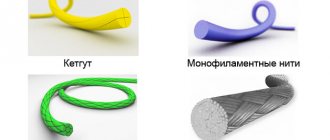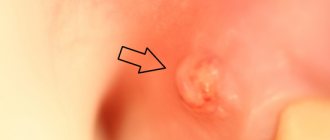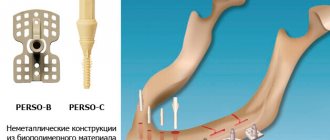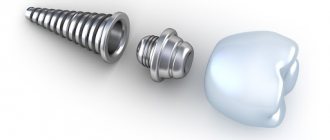Peri-implantitis is an inflammatory process that affects the mucous and bone tissues of the jaw at the site of installation of a dental implant. The danger of pathology lies in the resorption of the jawbone - as a result, the fixation of the artificial root is disrupted. The pathology is observed infrequently - in 2-5% of patients immediately or after a year. The main reason for the appearance is considered to be exposure to harmful microorganisms. In the initial stages, when inflammation has not affected the bone tissue (mucositis), conservative treatment is possible. If the inflammation has spread to the jaw, treatment is performed surgically. For prevention, choose an experienced doctor, high-quality artificial roots, and properly care for your oral cavity after surgery.
Symptoms
- Swelling, redness or blue discoloration of the gums;
- pain when pressing on the implant;
- mobility of the artificial root;
- discharge of pus, blood, formation of fistulas;
- peeling of the gums from the implant;
- temperature 38 degrees and above.
If you experience at least one of the signs, do not try to treat yourself. Contact a doctor, he will analyze the situation, conduct a diagnosis, and select a comprehensive treatment.
What does inflammation of soft tissues near or under the implant indicate?
Dental implantation is a complex traumatic operation, during which the integrity of soft and hard tissues is disrupted and blood vessels rupture. In the post-implantation period, swelling, bleeding, and pain are possible, which is a normal reaction of the body to injuries received.
These symptoms are not considered a pathology and go away on their own within 3-5 days. If pain and swelling persist for a longer period or tend to increase, this indicates the onset of inflammation - peri-implantitis.
Stages
- Easy . Minor loss of bone around the implant. Inflammation of the mucous membrane appears, the pain is not pronounced, and the artificial root wobbles slightly. Painkillers, antibiotics, and in some cases surgical treatment are prescribed.
- Average . Half of the vertical bone loss. Pus appears, bleeding, acute pain, the gums peel off, the implant is unstable. Surgical treatment or removal of the implant is prescribed.
- Heavy . Complete bone resorption. Deep gum pockets, spread of infection to neighboring areas, increased purulent discharge, prolonged bleeding. The implant will have to be removed.
It is considered normal to lose bone around the implant from one to one and a half millimeters in the first year and no more than 0.2 millimeters per year thereafter. Bone loss above these levels is pathological.
Treatment of complications
Depending on the stage of development of the disease, the following procedures are performed:
- surgical removal of a pus sac;
- antiseptic treatment of soft tissues;
- cleaning and removing the gum pocket;
- cleaning and disinfection of the implant;
- drug therapy.
If the inflammatory processes and suppuration progress, then perhaps the only solution will be to remove the implant.
Diagnostics
If you find signs of a disease or a suspicion arises from a doctor during a routine examination (during visual examination or palpation), a diagnosis must be carried out:
- Computer diagnostics. Panoramic X-ray or 3D computed tomography - to assess jaw resorption.
- Periapical x-ray. Obtaining information about the condition of the artificial root and the area around it.
- Probing. To assess the depth of the periodontal pocket.
Additional studies are prescribed:
- Dentistry - a detailed examination of the mucous membrane helps to see the internal picture of the anomaly in the initial stages.
- Clinical tests, Schiller's, Russell's tests, pH-metry.
- Biochemical, bacteriological tests provide additional information about the disease.
Based on the results, a diagnosis is made and appropriate treatment is prescribed.
Is plaque on the gums always considered normal?
The appearance of plaque in the oral cavity is noted by most patients after implantation. Natural processes and developing diseases during surgical intervention can contribute to the formation of a white to dark gray film.
Fibrinous plaque on a wound - how to distinguish it from inflammation
Often, a white coating appears on the surface of the gum during healing, which is formed from protein during blood clotting and is a natural defense that prevents infection from penetrating deep into the wound. This plaque is called fibrin , it should not cause concern.
There are situations when plaque is a sign of an inflammatory process or rejection of the structure. It differs in color and appearance, but only a doctor can determine this.
To independently distinguish normality from pathology, you need to take into account the healing process:
- On the day of implantation, a dark red or burgundy blood clot appears, and the mucous membrane may be swollen.
- On the second day, a white fibrin coating forms. The swelling may increase.
- With normal healing, plaque on the gums dissolves within 7 days after the formation of the epithelial barrier (the process of bone regeneration will continue for up to 3-6 months).
- On days 3-7, the swelling completely disappears, and the mucous membrane acquires a natural color. Sometimes fibrous plaque can still persist while epithelial tissue grows underneath it.
- By days 10-14, there is practically no plaque observed, the gums are covered with new tissue.
Implantologist's opinion : “After installation of the implant, the patient must note all changes in the oral cavity. The main sign of successful implantation is normal health. The white plaque does not need to be removed, as patients try to do, it is a natural protective reaction of the body. If by the end of the week the swelling and pain have disappeared, then there is nothing to worry about.
You need to carefully monitor any changes in your health, and if you have suspicious symptoms, immediately consult a doctor. After all, he is responsible for the results of the work performed and your condition. This means that it is within his competence to detect the problem even before the appearance of the first clinical symptoms.”
Manifestation of stomatitis
Stomatitis is a lesion of the oral mucosa that occurs in approximately 20% of people. At the initial stage, it manifests itself in the form of redness, swelling, burning, and then develops, turning into blisters or painful sores of a round or oval shape. They are white or gray in color, with a film on top and a red halo.
The disease lasts about 4-14 days. If once it appears, there is a possibility of relapses (repetitions). The typical frequency of exacerbations is 3-4 times a year. The ulcers heal calmly, leaving no traces.
The main reason for the appearance of plaque during stomatitis is considered to be the reaction of the immune system to irritants - when it cannot recognize new molecules. This provokes an attack of lymphocytes and leads to the formation of ulcers.
The development of stomatitis is promoted:
- insufficient hygiene;
- smoking, drinking alcohol;
- side effects of chemotherapy;
- dehydration (with prolonged elevated temperature, vomiting, diarrhea, blood loss);
- antibiotic therapy after tooth extraction and implant installation;
- low-quality or poorly installed implants.
Risk factors for stomatitis include:
- Gastrointestinal diseases: colitis, gastritis, duodenitis, helminthic infestation.
- mouthwashes and toothpastes containing sodium lauryl sulfate;
- emotional/mental stress;
- genetic predisposition;
- hormonal changes;
- mechanical trauma to soft tissues in the oral cavity (appears from hard food, sharp tooth fragments, uneven edges of the crown, etc.);
- bacteria and harmful microorganisms (can penetrate the wound during implantation);
- systemic diseases or malignant tumors;
- insufficient amount of vitamins and minerals in the body;
- increased tissue sensitivity;
- allergic reactions.
Treatment of stomatitis is carried out using two methods: local impact on the affected area and general strengthening of the immune system.
Among the medications prescribed are antibacterial and antiviral agents, ointments that accelerate the restoration of damaged epithelium. It is recommended to rinse the mouth with medicinal compounds and liquid antiseptics.
When rinsing the mouth, avoid swallowing medications.
In order to restore immunity, a course of intensive immunization, general strengthening procedures are prescribed, and stress factors are limited. Vitamins and a balanced diet will have a positive effect.
Effective folk methods:
- rinsing with soda solution;
- aloe and kalanchoe juice;
- flax seeds;
- egg white;
- tea mushroom;
- viburnum with honey;
- carrot juice;
- blueberry;
- onion broth;
- green tea;
- tincture of propolis or echinacea;
- decoctions of medicinal herbs (chamomile, St. John's wort, millennial, calendula, sage, oak, burdock root and seeds).
How to treat peri-implantitis without removing the implant
At the first stage, when the titanium root is stable and bone resorption is insignificant, removal of the implant can be avoided; the doctor selects the treatment method. If the disease is at the second or third stage, treatment is ineffective, the risk of relapse is high, so the implant is removed.
Treatment methods for the mild stage are used comprehensively:
Cleaning the artificial root
Removal of plaque and microflora contamination from the surface, antiseptic treatment. Ultrasound, laser or Air Flow is used. The difficulty lies in the active coating of the titanium roots, which can be damaged during cleaning. Cleansing with the Vector device will help solve this problem. This is an ultrasonic device with piezoceramic discs that remove plaque, bacteria, and biofilms from the surface of the implant without damaging the materials.
Therapy with antibacterial drugs
The drugs relieve inflammation, sometimes they are prescribed for general purposes, but a good doctor will first analyze the microflora to assess sensitivity to the drugs. Amoxicillin, Ceftriaxone, Amoxiclav are used - based on the results of an analysis of the microflora of the oral cavity.
Increased Bone Volume (BVR)
Bone regeneration is aimed at deep cleaning of the implant and restoration of bone size. A dissection and peeling of the gum is performed to access the defect area. Granulations, inflamed gingival and bone tissues are removed. Bone material is implanted and membranes are applied for fixation. This method is the most effective, as deep mechanical and antiseptic cleaning is carried out.
Correction of gum position
Aesthetic surgery is performed after bone grafting or independently in case of loss of gum tissue.
Use of bone growth stimulants
Keystone stimulators accelerate tissue regeneration and are used in our Center even at the stage of implant installation.
Prosthesis correction
It is necessary if the cause of the disease is overload of the implants. This occurs when an incorrectly selected prosthesis or a change in bite.
Doctor's advice - when is re-implantation possible?
After extracting the artificial root, a break is taken for 1-2 months. There is no need to wait any longer, otherwise jaw atrophy will begin. Reimplantation is combined with osteoplasty if there is enough bone and gum tissue in the implant area. Otherwise, after the hole has healed, bone augmentation is first carried out in a separate stage, and only then the implant is installed.
Levin Dmitry Valerievich
Chief physician, Ph.D.
Classification
Based on the time of occurrence after implant installation, peri-implantitis is divided into:
Early – the occurrence of rejection of the implant system before a month after surgery (reason – non-fusion of the implant with the jaw).
Medium-term – rejection within a period of three months to two years (reason – defects in calculating the load of the system on the alveolar process).
Late – the occurrence of problems with implants for a period of more than two years (the reason is the patient’s poor oral care).
Reasons for the development of peri-implantitis
Implants have a rough surface, which helps to better osseointegrate into bone tissue. When the artificial root is exposed, the surface is exposed to bacteria. If the patient does not maintain oral hygiene, bacterial plaque accumulates on the implant.
According to the results of early studies, the cause of the development of peri-implantitis is microbes of the intestinal group, and the role of fungi of the genus Candida has been established. According to the results of recent tests, the microflora is associated with bacteria that cause periodontitis. But it is still impossible to fully say which microbes cause the disease.
The causes of pathological bone loss and exposure of the implant neck may be medical errors or non-compliance with recommendations by the patient.
Doctor's mistakes
It is important to contact attentive and experienced doctors, because the success of implantation at the preparatory, surgical and orthopedic stages depends on them. Possible mistakes:
- Patient preparation. Insufficient sanitation of the oral cavity was carried out to eliminate pathogenic microflora, periodontal tissue diseases were not taken into account, and teeth were poorly treated. Implantation does not take into account chronic diseases, ENT pathologies, or the patient’s addictions to alcohol and smoking.
- Diagnostics. Using only OPTG data without CT to assess the condition and size of the jaw bone.
- Operation planning. Incorrectly selected implantation site, distances from neighboring teeth, sizes of bone and gum tissue are not taken into account.
- Surgical stage: deviation of the implant installation angle, failure to maintain sterility, damage to the titanium root coating, saliva getting into the prepared bed, use of non-original products.
- Prosthetics: overload of the artificial root with the prosthesis, loose connection of the implant and abutment, cement fixation of the crown, trauma to the mucous membrane.
Patient errors
Patients with chronic diseases should not hide their condition from their doctor. To obtain a favorable outcome, additional examinations and careful diagnostics will be required. An honest doctor will warn the patient about possible risks, and in case of absolute contraindications, refuse implantation.
Diseases that increase the risk of peri-implantitis include:
- bruxism – teeth grinding overloads the implants;
- Corticosteroid therapy leads to bleeding and delayed tissue healing;
- chemotherapy, HIV - immunosuppression occurs;
- Diabetes mellitus is a metabolic disorder.
The following also lead to the development of peri-implantitis:
- refusal to comply with hygiene rules or incorrect compliance;
- alcohol abuse, smoking;
- ignoring the treatment of chronic diseases.
Related articles:
- Rejection of dental implants
- Removing a dental implant
- Implantation guarantee
Tooth rejection after implantation, symptoms and causes
Patients' doubts before implantation surgery are associated with two main points: fear of pain and the possibility that the prosthesis will not take root. But before delving into this issue, it is necessary to clarify that pin rejection occurs in a maximum of 2% of operated patients. And if the most modern and high-quality implants are used, then the risk of complications drops to half a percent, that is, problems are observed in one person out of two hundred. Also, technologies and materials are constantly being improved, so the safety of this procedure will only increase over time.
How and why rejection occurs
During the first stage of implantation, a pin is installed in the jawbone - this is a metal rod that will act as a root for an artificial tooth. For it to hold normally, the bone must fuse with it and osseointegration occurs. If something goes wrong, the bone will not grow into the grooves of the pin, and inflammation will begin in the surrounding tissues. The same reaction will occur as if any foreign body enters the bone.
Types of inflammation
Most often, signs of rejection develop within a few days after surgery. Their frequency is slightly higher if the prosthesis was installed in two stages. However, there are cases when the implant began to be rejected after a few years. But these cases are most often associated with the development in the patient of any concomitant diseases that greatly undermine the person’s health. Inflammatory processes leading to prosthesis rejection include mucositis and peri-implantitis.
Mucositis
This is an inflammatory process that leads to ulceration of the mucous membrane. It develops when bacteria enters the tissue surrounding the top of the tooth. The inflammation affects only the surface of the gum, without affecting the root canal or bone. The gums around the implant acquire obvious signs of inflammation: they turn red and swell. With mechanical impact, painful sensations appear. This disease is treated conservatively, that is, without surgery. Use gels or ointments with antibiotics, antiseptic solutions. If treatment is started in a timely manner, the inflammation goes away, and then the implant takes root as it should. The risk of complete rejection appears if the disease starts and peri-implantitis develops.
Peri-implantitis
This is an inflammation of the tissues surrounding the pin. It can lead to very rapid rejection of the rod and loss of the prosthesis. In addition, it is much more severe than mucositis, accompanied by fever and suppuration. In severe cases, it leads to destruction of the alveolar bone. In case of peri-implantitis, the pin most often has to be removed; without this, the inflammation cannot be stopped.
Degrees of inflammation
• Mild – develops both spontaneously and as a result of untreated mucositis. The gums swell and hurt. An X-ray examination reveals bone destruction around the pin, but not more than 3 mm. In this case, anti-inflammatory therapy can be carried out. • Moderate – accompanied by increased pain, bleeding and discharge of pus from the canal. More than 3 mm of bone tissue is resorbed. It is necessary to remove the pin, sanitize the canal and treat the infection with antibiotics. • Severe – the alveolus is destroyed so much that a cavity forms in the gum. The pin is loose. Bleeding and pain increase, significant suppuration develops. Urgent removal of the structure and antibiotic therapy is necessary. Since peri-implantitis can begin soon after installation, when the gums are still swollen and painful due to surgery, there is a danger of missing the first symptoms.
Symptoms of implant rejection
Unlike the consequences of the installation, they do not weaken, but, on the contrary, progress. If within a week from the installation of the pin at least one of the symptoms appears or persists, you need to urgently contact the clinic. • Pain in the jaw: throbbing, worse with movement or constant, • Redness and swelling around the shaft, • Fever, • The appearance of pus, • Looseness of the pin or its loss.
If pus appears or the prosthesis becomes loose, you need to go to the doctor on the same day. The same applies to a fever of 38 degrees. Normally, there will be redness, pain and slight bleeding due to surgery, but they should gradually subside and completely disappear within a maximum of 2 weeks. If this does not happen, then you also need to go to the hospital, even if there is no pus or fever.
Reasons for denture rejection
Both types of inflammation described above develop due to infection. Normally, the tooth root and periodontium are sterile, and no foreign bodies enter there. And when installing an implant, there is a danger that pathogenic bacteria will enter the canal. There are several reasons why this could happen.
1. Medical errors. The process of preparing for implantation is quite complex, and if the doctor does not have sufficient qualifications, he may make the following mistakes: Insufficiently thoroughly examining the patient. It is wrong to choose the type of implant, or the place for its implantation, without taking into account the structural features of the jaw. Do not take into account the person’s condition at the time of surgery: the presence of acute infections, chronic diseases that slow down healing: diabetes, chronic sinusitis, periodontal disease. Improperly perform the operation, disrupt sterility due to saliva, or damage to the surface of the implant. Incorrectly calculate the parameters of the prosthesis, which will put an increased load on it. Allow dental cement to get into the wound. The outcome of the operation almost entirely depends on the choice of specialist. If everything is carried out according to the protocol, then the risk of rejection is the same 2%.
2. Violations on the part of the patient. After surgery, a person must strictly follow the rules of oral hygiene, take all prescribed medications and follow a diet. If the patient does not treat the wound regularly, eats too hard foods or does not take medications, then there is a high probability that the gums will be further injured and become infected. It is a mistake to think that artificial teeth do not need care. You should also come back periodically for checkups, both soon after surgery and in the future.
3. Poor quality prosthesis. Some people take a big risk by going to clinics that offer prosthetics much cheaper. In such cases, materials that are not certified are used. Cheap pins may have a poor-quality coating that is easily damaged, and the alloy itself may contain toxic impurities.
4. Concomitant diseases. Most often, chronic diseases are the cause of late rejection of dentures - after 2 or more years. This can happen due to exacerbation of the disease, decreased immunity. The state of the defense system is especially affected by: • Autoimmune diseases, • Diabetes mellitus, • Malignant tumors, • HIV infection. Also, inflammation can be triggered by a jaw injury at any time.
What to do if you suspect rejection
Self-help in this case is impossible; you need to go to a specialized clinic. The best option would be a consultation at the same hospital where the prosthetics was performed. Each original implant comes with a service book; you need to take it with you. The doctor will take a medical history and examine the oral cavity. A special probe will be used to examine the canal. An x-ray or computed tomography is performed. Modern devices make it possible to build a three-dimensional model of the tissue around the prosthesis and understand how much the bone has been damaged.
The choice of method and extent of treatment depends on the results of the examination.
In most cases, the implant is removed and the inflammation begins to be treated. If the cause of rejection is an exacerbation of another disease, then it is treated separately. If therapy is carried out in a timely manner, then after recovery a new structure can be installed. In case of rejection after two-stage implantation, osteoplasty is often required - restoration of the alveolus. Bone growth can take up to 6 months. With a one-stage operation, this can be avoided, especially if the process has not progressed far. Of course, the patient can refuse surgery in any case, but in this case, not only the prosthesis will be lost. Inflammation can spread to the bone, adjacent teeth, and in severe cases lead to sepsis.
| Submit your application |
What we guarantee
- Correct implantation, strict adherence to protocols. Our Center has a team of highly qualified doctors, employees of Moscow medical universities. Implantologists are proficient in all known protocols, and constantly undergo internships and advanced training courses in the USA, Germany, and surgical centers in Russia.
- Installation of high-quality Nobel Biocare implants. They have no restrictions on installation, are suitable for all clinical cases, the survival rate is 99.3%, and are protected from counterfeiting. Patented TI-Unite surface promotes faster healing. We provide a lifetime warranty.
- Thorough diagnosis. The center is equipped with modern diagnostic equipment, the results will be known in 15 minutes.
- Quick response to problem . You can call us at any time of the day or any day of the week if something is bothering you. In addition, we conduct preventive examinations and free CT examinations after surgery.
Prevention
Peri-implantitis is one of the most common complications in dental implantology. For the purpose of prevention, a set of preventive measures has been developed; if observed, the development of peri-implantitis tends to zero.
After dental implantation it is recommended:
- Visit a specialist regularly, twice a year, for preventive examinations.
- Complete professional hygiene procedures within the prescribed time frame.
- Constantly care for your teeth and gums using special pastes and toothbrushes.
- On a systematic basis, undergo implant care procedures in the clinic.
- Eliminate excessive loads on the implant.
- The patient should avoid damaging the implanted dental system.
- Take x-rays regularly and monitor the condition of the bone plate.
- Treat all inflammatory processes in the oral cavity in a timely manner.
It is enough to follow all these simple rules so that peri-impantitis does not develop.
